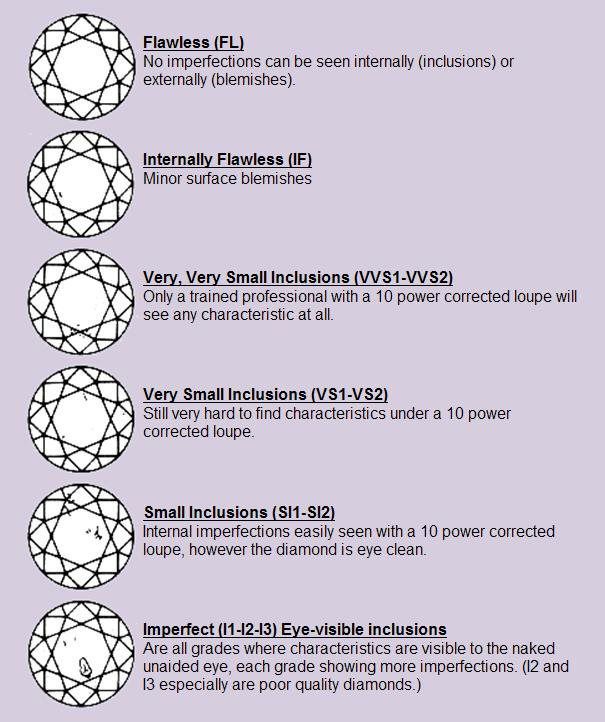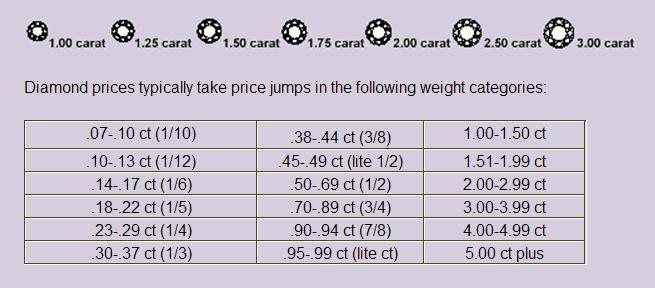Diamond Information

Tradition and Lore of Diamonds
Until the 15th Century, only Kings wore diamonds as a symbol of strength.
The Greek word "Adamas" meaning unconquerable and indestructible is the root word of diamond. Diamonds have been sought the world over, fought over, worshipped and used to cast love spells. For the last 3000 to 4000 years, diamonds have held special magic for Kings, Queens and their subjects. Diamonds have stood for wealth, power, love, spirit and magical powers. Kings in olden days would wear into battle heavy leather breast plates studded with diamonds and other precious stones. It was believed that diamonds were fragments of stars and the teardrops of the Gods. The diamonds possessed magical qualities of the Gods and held powers far beyond the understanding of the common man. Because of these beliefs, the warriors stayed clear of the Kings and others who were fortunate to have the magical diamonds in their breast plates. Until the 15th Century only Kings wore diamonds as a symbol of strength, courage and invincibility. Over the centuries, the diamond acquired its unique status as the ultimate gift of love. It was said that cupids' arrows were tipped with diamonds that have a magic that nothing else can equal. Since the creation of diamonds they have been associated with romance and legend. The Greeks believed the fire in the diamond reflected the constant flame of love. For millions of people around the world, the mystery and magic, the beauty and romance shining out from a simple solitaire says all the heart feels but words can not express. It wasn't until 1477 when Archduke Maximilian of Austria gave a diamond ring to Mary of Burgundy, that the diamond engagement ring was introduced. Placing the ring on the third finger of the left hand, dates back to the early Egyptian belief that the Vena Amors, vein of love, runs directly from the heart to the tip of the third finger.
Origin and Age of Diamonds
They travel to the earth's surface in volcanic pipes
Diamonds were formed over 3,000,000,000 years ago at depths of over 93 miles deep into the earth's surface. It is there where the earth's tremendous pressure of up to 870,000 pounds per square inch and intense temperature of up to 1,300 degrees Celsius transform the carbon atoms into diamonds. They travel to the earth's surface in volcanic pipes, dikes and sills. Most diamonds today are found in volcanic pipes, like the Sytikansek Pipe and the International Pipe, located in Sakha the Russia Federation, CIS. There is the Premier Mine in Cullinan South Africa and the Jagersfontine Mine, also found in South Africa this mine was closed in 1971 and the nearby Koffiefontein Mine was re-opened.

The 4 C's: Cut
Differences in cutting could affect a diamond's beauty
First we must distinguish the definition of cut. Cut does not refer to the shape of the diamond, as in round, pear, marquise... Cut refers to the proportion of the diamond. Differences in cutting could affect a diamond's beauty, durability and cost. The cutting and proportioning of a diamond is also referred to as the "make". Proper cutting and proportioning will release the full beauty of a diamond. A well-cut diamond could fetch a higher price tag because fine cutting requires skill and experience and takes more time. The proportioning, especially the height of the crown in relation to the depth of the pavilion and the width of the table facet in relation to the width of the stone, is what determines how much brilliance and fire the stone will have.

The 4 C's: Color
Diamonds come in many colors
Diamonds come in many colors, but the overwhelming majority sold in the jewelry industry range from nearly colorless to very light yellow or brown. The most prized diamonds are colorless (D-E-F), because their beauty depends on their optical properties. The color grading scale established by G.I.A. (Gemological Institute of America) varies from D (totally colorless) to Z (light yellow). Each letter grade represents a range of color. To color grade, diamonds are compared to diamonds of known color, called master stones. This set defines G.I.A.'s diamond color grades and all diamonds are compared to them.
- D through F are virtually colorless.
- G, H and I diamonds appear colorless when mounted.
- J, K and L diamonds look very nearly colorless, but you can see some coloring in larger stones.
- M and beyond, most people can see color pretty easily.

The 4 C's: Clarity
As it forms in nature, almost every diamond develops imperfactions
Diamonds come in many colors, but the overwhelming majority sold in the jewelry industry range from nearly colorless to very light yellow or brown. The most prized diamonds are colorless (D-E-F), because their beauty depends on their optical properties. The color grading scale established by G.I.A. (Gemological Institute of America) varies from D (totally colorless) to Z (light yellow). Each letter grade represents a range of color. To color grade, diamonds are compared to diamonds of known color, called master stones. This set defines G.I.A.'s diamond color grades and all diamonds are compared to them.
- D through F are virtually colorless.
- G, H and I diamonds appear colorless when mounted.
- J, K and L diamonds look very nearly colorless, but you can see some coloring in larger stones.
- M and beyond, most people can see color pretty easily.

The 4 C's: Carat Weight
Carat weight is a unit of measure used to weight gemstones
All precious gemstones, including diamonds, have a weight which is expressed in carats. One carat is divided into 100 "points" so that a diamond of 50 points is described as a half carat in size, or 0.50 carat. Size is one of the factors in determining the value of the diamond, but other factors such as cut, clarity and color will also effect the final price.
Diamond Enhancements
To recognize a filled diamond, look for flattened gas bubbles
An enhancement is any process that alters the appearance of a diamond, such as lasered, fracture filled, or irradiated.
Lasered Stone
A lasered stone is one that has been laser drilled into the diamond to a dark inclusion then boiled in acid to remove the dark substance. This leaves a white inclusion and a very small (microscopic) hole; this is a permanent change to the diamond so it is the only enhancement that most labs will certify.
Filled Diamonds
Filled diamonds are diamonds that either have a fracture or cleavage that reaches the surface, they then fill it with a glass or epoxy to make the fracture less visible. Heating these stones during setting or repair can cause the filling to discolor, and even melt and leak out. To recognize a filled diamond look for flattened gas bubbles, web like patterns in the filling; it may appear greasy or oily at the filling, and yellowish looking cloudy areas. One of the big things to look for is the flash effect, under darkfield illumination while looking on the same plane as the crack you can see a single color and then if the stone is tilted slightly you will usually see a second color. These colors are usually yellowish orange and blue or pinkish purple and yellowish green. A filled laser hole usually appears to be a tiny yellow line.
Irradiated Diamond
An irradiated diamond is when the diamond is exposed to high amounts of radiation, which artificially alters or improves the color of the diamond. Once color treated with radiation the diamond can now have a dark, color such as blue or green. This is much less expensive then a natural dark colored diamond.